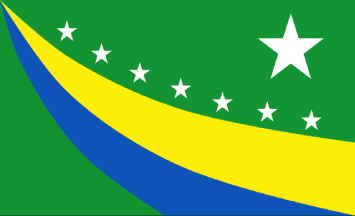
image from Wikimedia Commons

Last modified: 2025-07-05 by daniel rentería
Keywords: bolivar | caroni | ciudad guayana |
Links: FOTW homepage |
search |
disclaimer and copyright |
write us |
mirrors

image from Wikimedia Commons
See also:
According to esequibonews.com.ve: The flag and coat of arms were presented on 19 December 2024; being first
selected on 15 December. It is reported 44,385 people voted for the symbols, with over 95% agreeing with the adoption of municipal symbols. The design was created by Johangela Lugo. It features,
over a green field, two curved lines: the one on top yellow and the one on the bottom blue, going from the upper-left corner to the lower-right. Going across are seven stars, with one big one above
the rest. Green represents the abundant vegetation and hills of Ciudad Guayana, while the yellow and blue lines are for the Orinoco and Caroní rivers. The eight white stars represent the
provinces in the War of Independence. and the largest one represents the Guayana Province.
The symbols were adopted through a competition held by the Municipal Council that started in March 2024
through a request by the Mayor, receiving 28 proposals and to be presented on April 11, but delayed heavily; a jury narrowed proposals down to 3 in each category. Previously, the municipality had
no flag.
Daniel Rentería, 27 June 2025
.gif)
from Wikimedia Commons
The new coat of arms was designed by Jeffrey Morles and presented on 19 December 2024 along with the municipal flag. Description as commonly seen online:
1. The border or external structure of the shield is of orange color, in representation of the evening twilights which we enjoy daily in the sky of the municipality.
2. In the upper-left section, a sky of intense and pure blue color which contains 11 stars, one for each parish of the municipality. The horserider of the horse reminds us of the historic heritage of battles and heroes that sowed in these lands their legacy of fight and independence.
3. In the upper-right section the representation of natural splendor, where the force of water blesses all in its path.
4. The lower-central section represents the union of our Caroní and Orinoco Rivers, an ancestral history that values identity.
5. The cogwheel crowns the shield, representing industry, inventiveness, entrepreneurship, and the trust in the working force of Guayana and Venezuela.
6. The ribbon with the date 11 de Abril de 1817 is the battle of San Félix; the patriots at the mandate of Manuel Carlos Piar obtained not just the rich territory of Guayana, rather the immense path, very useful, of the Orinoco. The campaign of Guayana was the most transcendental and one of the most beautiful of our historic cycle.
Daniel Rentería, 27 June 2025
.gif)
from Wikimedia Commons
The previous coat of arms was designed by heraldist of Spanish origin Antonio de la Nuez Caballero in 1967, along with the Municipal Anthem. A common description is provided and translated:
The Shield is found surrounded by a blue border with eight stars [for the eight provinces that fought against Spain, including Guayana]; divided by two principal sections.
In the upper-left section, it contains a boat of deployed sails, which represent one of those that made commerce to the Indias in the 18th century, in the lower part three pineapples of our continent which represent fruit discovered and converted into a symbol of tropical America, by image of the Europeans. [The entire left half references the coat of arms granted by Carlos IV to the Province of Guayana].
In the second section, the present and future are represented. The triangle with a form of a hole colored red signifies the fight, the human effort of converting mining wealth and utilizing the energy of the country and putting it to produce. The shield, crowned over wavy lines, represent two rivers, the Orinoco and Caroní; the rounded millstone symbolizing the name of Father of the Fatherland, the state and first widely productive human machine.
In the lower part is a ribbon colored yellow in which the most important years of the life of Santo Tomé de Guayana are identified. [21 Diciembre de 1595 (foundation of Santo Tomé); 11 Abril de 1817 (battle of San Félix); 2 Julio 1961 (foundation of Ciudad Guayana)].
Daniel Rentería, 27 June 2025